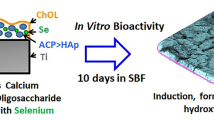Abstract
Silica formation aided by polypeptides is being actively investigated for a wide range of applications including biomaterials synthesis, ceramics and controlled release systems. We envision that biocatalyzed mineralization could have application as a dental material wherein situ formation of mineral layers could provide needed wear-resistance or sealing capability. The approach would be more clinically relevant, if a polymer host could be used to carry and specifically position the biocatalyst on a surface and additionally maintain the catalyst activity.
Accordingly, we studied the influence of simple catalytic polypeptides on silica formation from prehydrolyzed alkoxide precursor solutions onto a surface. The polypeptides were localized on to the surface as multilayered thin films using the layer-by-layer (LbL) assembly of polyelectrolytes. Polylysine (PLL) or another biocatalytic polycation, poly(ethyleneimine) (PEI), was adsorbed layer-by-layer up to 10 bilayers on silicon wafers in combination with a negatively charged polyelectrolyte polymer host, poly(sodium-4-styrene sulfonate) (PSS) to prepare PEI-(PLL/PSS)10, PEI-(PEI/PSS)10 and PEI-(PEI/PSS/PLL/PSS)10 multilayer films. Pre-hydrolyzed alkoxysilane solutions were placed dropwise on the catalytic films for silicification. Additionally, the effects of precursor concentration, solvent and drying were evaluated. The morphology, roughness and contact mechanical stiffness of the formed silica were investigated using optical microscopy (OM), scanning electron microscopy (SEM) and atomic force microscopy (AFM).
The resulting silica morphology was plate-like or spherical, and porous with average particle size depending on the catalyst and its positions on the surface. Without a catalyst the silica formed over longer times with a fine, gel-like appearance. The morphology of silica produced on the substrate was different from that of particles catalyzed in solution with the same polypeptide catalyst. Additionally, it was found that the homogeneity of PEI-(PLL/PSS)10 films increased with drying temperature, silica precursor concentration and the presence of ethanol. The contact mechanical stiffness of the silica particles (40 N/m) catalyzed from PEI-(PLL/PSS)10 films was lower than the non-silicified areas (48 N/m) suggesting that regions of the silica were amorphous and hydrated. These results show that a polypeptide applied to a surface as a multiple layer with an oppositely charged polymer host (PSS) maintains its activity for silicification. The generally coherent nature of the mineral coating suggests its potential for enhancing critical restorative dental interfaces; however properties like porosity, hydration and their effect on hardness and permeability will need further study.
Similar content being viewed by others
References
N. Kroger, R. Deutzmann, M. Sumper, Science 286, 1129 (1999).
P. J. Lopez, C. Gautier, J. Livage, T. Coradin, Current Nanoscience 1, 73 (2005).
S. Mann, G. Ozin, Nature 382, 313 (1996).
S. V. Patwardhan, S. Clarson, Silicon Chemistry 1, 207 (2002).
T. Coradin, J. Livage, Colloids and Surfaces B: Biointerfaces 21, 329 (2001).
S. V. Patwardhan, N. Mukherjee, S. Clarson, J. Inorganic and Organometallic Polymers 11, 193 (2001).
S. V. Patwardhan, N. Mukherjee, S. J. Clarson, Silicon Chemistry 1, 47 (2002).
F. Rodriguez, D. D. Glawe, R. R. Naik, K. P. Hallinan, M. O. Stone, Biomacromolecules 5, 261 (2004).
M. Tomczak et al., J. Am. Chem. Soc. 126, 12 (2005).
T. Coradin, A. Marchalo, N. Abdoul-Aribi, J. Livage, Colloids and Surfaces B: Biointerfaces 44, 191 (2005).
R. T. Butler, N. J. Ferrell, D. J. Hansford, Applied Surface Science 1, 1 (2005).
R. R. Naik et al., Progress in Organic Coatings 47, 249 (2003).
M. Advincula, R. Advincula, J. Lemons, Polymer Preprints (ACS) 45, 496 (2004).
C. Lefaux, J. Zimberlin, A. Dobrynin, P. T. Mather, J. Polymer Sci. Part B: Polym. Phys. 42, 3654 (2004).
X. Shi, M. Shen, H. Mohwald, Prog. Polym. Sci. 29, 987 (2004).
Y. Lvov, K. Ariga, I. Ichinose, T. Kunitake, J. Am. Chem. Soc. 117, 6117 (1995).
N. Nakabayashi, N. Honda, J. Japan. Soc. Den. Mat. 6, 873 (1987).
Y. Zhang, K. Agee, D. H. Pashley, E. L. Pashley, J. Clin. Periodontol. 25, 884 (1998).
J. Cha et al., Proc. Natl. Acad. Sci. 96, 361 (1999).
C. J. Brinker, G. W. Scherer, Sol-gel Science: The Physics and Chemistry of Sol-Gel Processing (Academic Press, Inc., New York, 1990).
Author information
Authors and Affiliations
Rights and permissions
About this article
Cite this article
Advincula, M.C., Patel, P.A., Mather, P.T. et al. Directed Mineralization on Polyelectrolyte Multilayer Films. MRS Online Proceedings Library 975, 603 (2006). https://doi.org/10.1557/PROC-975-0975-DD06-03
Received:
Accepted:
Published:
DOI: https://doi.org/10.1557/PROC-975-0975-DD06-03




